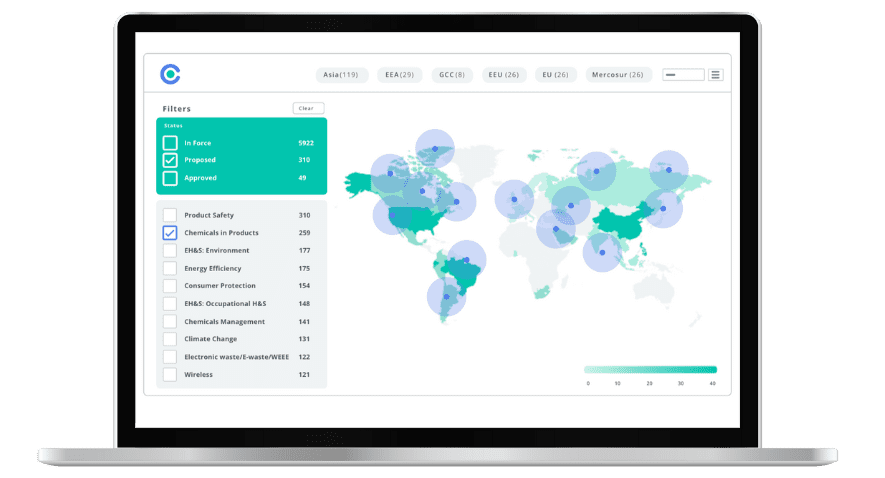
New Testing Standards to Apply Under China RoHS From 1 March 2024

This blog was originally posted on 29th January, 2024. Further regulatory developments may have occurred after publication. To keep up-to-date with the latest compliance news, sign up to our newsletter.
AUTHORED BY JOYCE COSTELLO, SENIOR REGULATORY COMPLIANCE SPECIALIST, COMPLIANCE & RISKS
Introduction
On 6 January 2016, China adopted its new RoHS regulation, known as China RoHS 2. It established a two step approach on restricted use of hazardous chemicals in electrical and electronic products which included new labeling requirements and conformity assessment requirements.
Recently, China’s National Certification and Accreditation Administration (CNCA) has announced a change in the applicable conformity assessment system testing methods under China RoHS, effective from 1 March 2024. Here’s what you need to know.
China RoHS: New Testing Standards
In order to be consistent with international standards for testing methods of hazardous substances in electrical and electronic products, the testing method standard for the conformity assessment system for restricted use of hazardous substances in electrical and electronic products, currently GB/T 26125, is being modified to the GB/T 39560 series of standards for the determination of substances, specifically the following 8 standards:
- GB/T 39560.1 Determination of certain substances in electrical and electronic products—Part 1: Introduction and overview
- GB/T 39560.2 Determination of certain substances in electrical and electronic products—Part 2: Disassembly, disjointment and mechanical sample preparation
- GB/T 39560.301 Determination of certain substances in electrical and electronic products—Part 3-1: Screening lead, mercury, cadmium, total chromium and total bromine by X-ray fluorescence spectrometry
- GB/T 39560.4 Determination of certain substances in electrical and electronic products—Part 4: Mercury in polymers, metals and electronics by CV-AAS, CV-AFS, ICP-OES and ICP-MS
- GB/T 39560.5 Determination of certain substances in electrical and electronic products—Part 5: Cadmium, lead and chromium in polymers and electronics and cadmium and lead in metals by AAS, AFS, ICP-OES and ICP-MS
- GB/T 39560.6 Determination of certain substances in electrical and electronic products—Part 6: Polybrominated biphenyls and polybrominated diphenyl ethers in polymers by gas chromatography-mass spectrometry (GC-MS)
- GB/T 39560.701 Determination of certain substances in electrical and electronic products—Part 7-1: Hexavalent chromium—Presence of hexavalent chromium [Cr(VI)] in colorless and colored corrosion-protected coatings on metals by the colorimetric method
- GB/T 39560.702 Determination of certain substances in electrical and electronic products—Part 7-2: Hexavalent chromium—Determination of hexavalent chromium [Cr(Ⅵ)] in polymers and electronics by the colorimetric method
The GB/T 39560 series corresponds to the IEC 62321 series of standards.
Transition Timeline
It will be recalled that under China RoHS conformity assessment is mandatory only for electrical and electronic products listed in the first batch of the Compliance Management Catalogue and manufactured or imported after 1 November 2019. This can be done through two approaches, either voluntary certification or self-declaration, at the discretion of manufacturers/suppliers. Until this recent announcement, products were required to be tested in accordance with GB/T 26125.
The transition is being implemented as follows:
- Starting from 1 March 2024, the testing methods for conducting conformity assessment activities for the restricted use of hazardous substances will be implemented in accordance with the GB/T 39560 series of standards
- Before 1 March 2024, if the conformity assessment is completed in accordance with GB/T 26125, the standard conversion will be completed through normal transition methods such as expiration of certificate renewal, product change, etc.
- Products that have been shipped or imported before 1 March 2024 do not need to undergo standard conversion.
What’s Next for China RoHS?
Other planned revisions to China RoHS are in progress, including the addition of four phthalates (DEHP, BBP, DBP and DIBP) to the hazardous substance list of China RoHS and development of a mandatory standard for hazardous substances restriction and labeling, effectively combining existing Standards SJ/T 11364 and GB/T 26572.
Developments regarding the foregoing will be notified in C2P if and when they arise.
Stay Ahead Of Regulatory Changes
Accelerate your ability to achieve, maintain & expand market access for all products in global markets with C2P – Your key to unlocking market access, trusted by more than 300 of the world’s leading brands.
C2P is an enterprise SaaS platform providing everything you need in one place to achieve your business objectives by proving compliance in over 195 countries.
C2P is purpose-built to be tailored to your specific needs with comprehensive capabilities that enable enterprise-wide management of regulations, standards, requirements and evidence.
Add-on packages help accelerate market access through use-case-specific solutions, global regulatory content, a global team of subject matter experts and professional services.
- Accelerate time-to-market for products
- Reduce non-compliance risks that impact your ability to meet business goals and cause reputational damage
- Enable business continuity by digitizing your compliance process and building corporate memory
- Improve efficiency and enable your team to focus on business critical initiatives rather than manual tasks
- Save time with access to Compliance & Risks’ extensive Knowledge Partner network

RoHS Updates – What You Need To Know On The New Exemption Renewal Timeline
Learn about the exemption review process, and what manufacturers should do to ensure that they comply in our latest webinar


